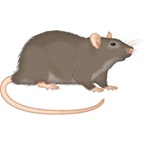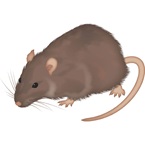House Mouse
Species category: Rodent
Scientific Name: Mus musculus
Family: Muridae
Description
Adults are typically 60-90mm. They have a tail length of 80-100mm long and weigh 15g-33g maximum. Droppings can be useful for identification purposes; theirs are formed like grains of rice and are approximately 3-6mm long.
Behaviour
Mice never move too far from their nest, and always use the same route when travelling to and from it, preferring to navigate around the edge of a room. Grease build-up in their fur from urine and dust creates smear marks which can be evident.
Region
The House mouse originated from East-Asia and has spread throughout the world in distributed grain and food.
Habitat
They will live close to a source of food and destroy materials in the vicinity to build a nest.
Risks
Mice are practically incontinent and urinate frequently. As a result, a mice infestation is normally recognisable from the distinct musty smell of their urine. They contaminate all surfaces that they scurry across with urine and faeces. They can produce up to 80 droppings a day.
Commercially, they cause direct food losses to stored food and food production chains, as well as indirect food losses, such as packaging destruction.


